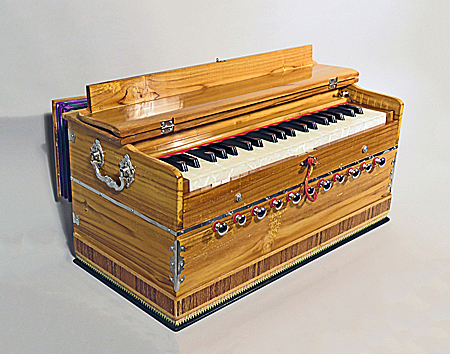
Owner: HWMC
Catalogue #: 2AS-AEFR-03
Free Reed
India 'Harmonium'
India
Indian
Teak wood, alabaster, metal, reeds, metal wire
Length: 23.75 in, Width: 12.25 in, Depth: 11 in
Early 21st century
Aerophones – Free Aerophones – Free Reed
The harmonium is a free-reed aerophone introduced to India by French missionaries, probably in the mid-19th century. In India, it is a small portable instrument set in a box. When played the performer usually sits on the ground or floor, plays the keyboard with one hand and pumps the bellows at the back with the other hand. Inside are a set of free reeds, whose length determines their pitch, activated by a wind supply from the hand-operated compression bellows and controlled by a keyboard. On keyboard instruments only straight notes can be placed, grace notes and quartertones are not possible. Therefore, the ornamentation such as slurs or gamaka, which are the main essence of the Hindustani ragadari system is not possible. For this reason, the harmonium was banned in music broadcasts over the National network from March 1940 to October, 1970. Today the harmoniums are better made and acceptable in urban and classical styles, but still less frequently found in the music of the villages. In adddition, the harmonium is considered not in vogue in the Carnatic music system of South India today.
This portable harmonium has a three and a half octave keyboard of ebony and alabaster keys with 11 silver metal scale changers underneath the keyboard. The body of the instrument is made of teak wood, with two stylized chrome handles on the sides for carrying. There is a locking lid which comes over the keyboard for protection during transport and storage, and the bellows are held closed by two moveable wires. Marked on this harmonium is “SHARMA G”. The 42 keys (notes) consist of the seven swaras (shortened to Sa, Ri/Re (Carnatic) (Hindustani), Ga, Ma, Pa, Dha, and Ni). Collectively these notes are known as the sargam, which is the Indian equivalent to solfège, a technique for the teaching of sight-singing.
